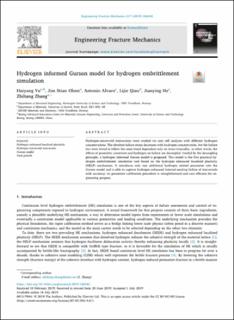| dc.contributor.author | Yu, Haiyang | |
| dc.contributor.author | Olsen, Jim Stian | |
| dc.contributor.author | Alvaro, Antonio | |
| dc.contributor.author | qiao, lijie | |
| dc.contributor.author | He, Jianying | |
| dc.contributor.author | Zhang, Zhiliang | |
| dc.date.accessioned | 2020-12-23T13:41:51Z | |
| dc.date.available | 2020-12-23T13:41:51Z | |
| dc.date.created | 2019-07-08T13:39:39Z | |
| dc.date.issued | 2019 | |
| dc.identifier.issn | 0013-7944 | |
| dc.identifier.uri | https://hdl.handle.net/11250/2720968 | |
| dc.description.abstract | Hydrogen-microvoid interactions were studied via unit cell analyses with different hydrogen concentrations. The absolute failure strain decreases with hydrogen concentration, but the failure loci were found to follow the same trend dependent only on stress triaxiality, in other words, the effects of geometric constraint and hydrogen on failure are decoupled. Guided by the decoupling principle, a hydrogen informed Gurson model is proposed. This model is the first practical hydrogen embrittlement simulation tool based on the hydrogen enhanced localized plasticity (HELP) mechanism. It introduces only one additional hydrogen related parameter into the Gurson model and is able to capture hydrogen enhanced internal necking failure of microvoids with accuracy; its parameter calibration procedure is straightforward and cost efficient for engineering purpose. | en_US |
| dc.language.iso | eng | en_US |
| dc.publisher | Elsevier | en_US |
| dc.rights | Attribution-NonCommercial-NoDerivatives 4.0 Internasjonal | * |
| dc.rights.uri | http://creativecommons.org/licenses/by-nc-nd/4.0/deed.no | * |
| dc.subject | Void growth | en_US |
| dc.subject | Gurson model | en_US |
| dc.subject | Hydrogen-microvoid interaction | en_US |
| dc.subject | Hydrogen enhanced localized plasticity | en_US |
| dc.title | Hydrogen informed Gurson model for hydrogen embrittlement simulation | en_US |
| dc.type | Peer reviewed | en_US |
| dc.type | Journal article | en_US |
| dc.description.version | publishedVersion | en_US |
| dc.rights.holder | 2019 The Authors. Published by Elsevier Ltd. This is an open access article under the CC BY-NC-ND license (http://creativecommons.org/licenses/BY-NC-ND/4.0/).T | en_US |
| dc.source.pagenumber | 12 | en_US |
| dc.source.volume | 217 | en_US |
| dc.source.journal | Engineering Fracture Mechanics | en_US |
| dc.identifier.doi | 10.1016/j.engfracmech.2019.106542 | |
| dc.identifier.cristin | 1710640 | |
| dc.relation.project | Norges forskningsråd: 234130 | en_US |
| dc.source.articlenumber | 106542 | en_US |
| cristin.unitcode | 7401,80,64,0 | |
| cristin.unitname | Materialer og nanoteknologi | |
| cristin.ispublished | false | |
| cristin.fulltext | postprint | |
| cristin.qualitycode | 1 | |

